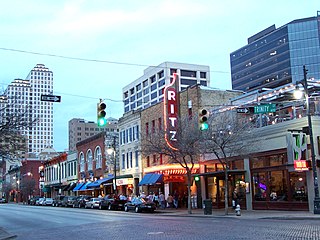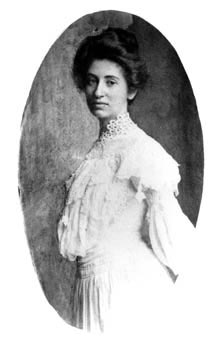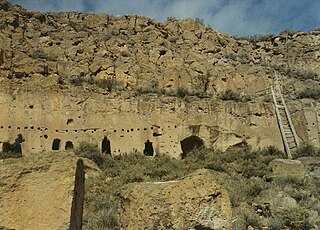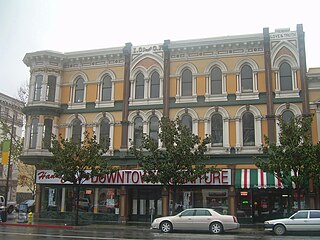
Sixth Street is a historic street and entertainment district in Austin, Texas, located within the city's urban core in downtown Austin. Sixth Street was formerly named Pecan Street under Austin's older naming convention, which had east–west streets named after trees and north–south streets named after Texas rivers.

Mary Elizabeth Jane Colter was an American architect and designer. She was one of the very few female American architects in her day. She was the designer of many landmark buildings and spaces for the Fred Harvey Company and the Santa Fe Railroad, notably in Grand Canyon National Park. Her work had enormous influence as she helped to create a style, blending Spanish Colonial Revival and Mission Revival architecture with Native American motifs and Rustic elements, that became popular throughout the Southwest. Colter was a perfectionist, who spent a lifetime advocating and defending her aesthetic vision in a largely male-dominated field.

The Puye Cliff Dwellings are the ruins of an abandoned pueblo, located in Santa Clara Canyon on Santa Clara Pueblo Reservation land near Española, New Mexico. Established in the late 1200s or early 1300s and abandoned by about 1600, this is among the largest of the prehistoric Indian settlements on the Pajarito Plateau, showing a variety of architectural forms and building techniques.

The Downtown Historic District of San Jose, California is a designated U.S. Historic District area of the city roughly the size of one square block. It is bounded by S. First Street to the west, E. San Fernando Street to the south, S. Third Street to the east, and E. Santa Clara Street to the north, but also includes the south side of E. Santa Clara Street between Third and Fourth Streets.

The Hayes Mansion is a historic mansion estate in the Edenvale neighborhood of San Jose, California. The mansion currently operates as a hotel resort and is currently known as Hayes Mansion San Jose, Curio Collection by Hilton. The hotel has been a member of Historic Hotels of America, the official program of the National Trust for Historic Preservation, since 2019.

The Telluride Historic District encompasses a significant portion of the developed area of the former mining boom town of Telluride, Colorado. Telluride was founded in 1878, and was a major metals mining center until 1913. The historic district covers 80 acres (32 ha) of downtown Telluride and surrounding residential areas, as well as Lone Tree Cemetery, the town's first cemetery. It was declared a National Historic Landmark in 1961 for its well-preserved late boom-town architecture.

The Wagon Mound is a butte that was a major landmark for pioneers along the Cimarron Cutoff of the Old Santa Fe Trail, a well-known settlement route connecting St. Louis, Missouri and Santa Fe, New Mexico. It is located just east of Wagon Mound, New Mexico, a village named after the butte. The butte is a designated National Historic Landmark, along with Santa Clara Canyon, a site just northwest of the village where travelers on the trail frequently camped and took on water.

This is a list of the National Register of Historic Places listings in Walworth County, Wisconsin. It is intended to provide a comprehensive listing of entries in the National Register of Historic Places that are located in Walworth County, Wisconsin. The locations of National Register properties for which the latitude and longitude coordinates are included below may be seen in a map.

Louis Singleton Curtiss was a Canadian-born American architect. Notable as a pioneer of the curtain wall design, he was once described as "the Frank Lloyd Wright of Kansas City". In his career, he designed more than 200 buildings, though not all were realized. There are approximately 30 examples of his work still extant in Kansas City, Missouri where Curtiss spent his career, including his best known design, the Boley Clothing Company Building. Other notable works can be found throughout the American midwest.

The Mission Revival style was part of an architectural movement, beginning in the late 19th century, for the revival and reinterpretation of American colonial styles. Mission Revival drew inspiration from the late 18th and early 19th century Spanish missions in California. It is sometimes termed California Mission Revival, particularly when used elsewhere, such as in New Mexico and Texas which have their own unique regional architectural styles. In Australia, the style is known as Spanish Mission.

The Las Vegas Plaza is a plaza and historic district in Las Vegas, New Mexico. The plaza was originally laid out in 1835 by Mexican settlers and is surrounded by a number of historically and architecturally notable buildings. It was listed in the National Register of Historic Places in 1974.

The Bullard Hotel, at 105 S. Bullard St. in Silver City, New Mexico, was built in 1916. It was listed on the National Register of Historic Places in 1988.

The Douglas-Sixth Street Historic District, in Las Vegas, New Mexico, is a historic district which was listed on the National Register of Historic Places in 1983. The listing included 18 contributing buildings, a contributing site, and two contributing objects.

The Alvarado Hotel was a historic railroad hotel which was one of the most famous landmarks of Albuquerque, New Mexico. It was built in 1901–02 by the Atchison, Topeka and Santa Fe Railway and was operated by the Fred Harvey Company until 1970. With 120 guest rooms, it was the largest of all the Harvey hotels. Its demolition by the railroad in 1970 was described by preservationist Susan Dewitt as "the most serious loss of a landmark the city has sustained" and helped mobilize stronger support for historic preservation efforts in the city.

The South Main Street Historic District in Memphis, Tennessee, is located south of the city's central business district encompassing over 100 mostly commercial buildings spread across 11 blocks. The area was constructed between 1900 and 1930 in a wide range of early-twentieth-century architectural styles including Beaux Arts, Georgian Revival, Art Deco and Chicago Commercial. The district was added to the National Register of Historic Places in 1982 as an area of Memphis representing the impact of the railroad on the city during the a period of railroad-led prosperity that ended with the Great Depression. The district includes the Lorraine Motel, constructed in 1925, where Martin Luther King Jr. was assassinated in 1968. The South Main Arts District is a smaller area within the historic district. The district is also a City of Memphis local historic district or Historic Overlay District.

The Los Gatos Historic Commercial District of Los Gatos, Santa Clara County, California is a designated U.S. Historic District area of the city. The commercial district comprises a collection of commercial buildings that is bounded by both sides of West Main Street, North Santa Cruz Avenue, and University Avenue. These streets form an F-plan layout extending westward from the Main Street bridge situated in the southwestern region of the town of Los Gatos. The district covers the town's original commercial intersection and includes a substantial segment of its 19th-century commercial center. Within this area lies the sole surviving cluster of historic commercial buildings, reasonably well-preserved. The architectural styles within the district span from the Queen Anne style architecture and Richardsonian Romanesque, representing a broad spectrum of design trends, including Art Deco. The Los Gatos Historic Commercial District was placed on the National Register of Historic Places on September 13, 1991. Today, the historic commercial district remains a commercial hub and plays a role in local tourism.

















